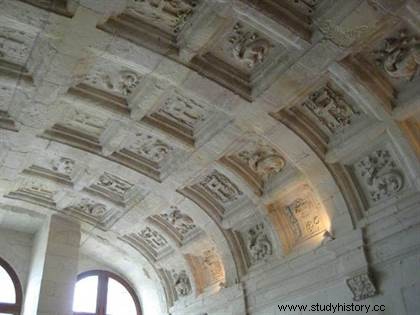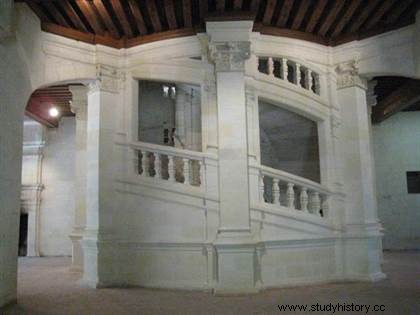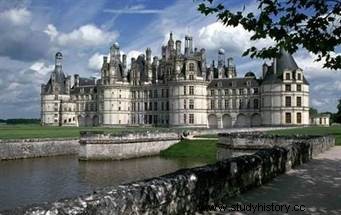 The largest castle in the Loire, the Château de Chambord built to the glory of François I
st
consists of more than 400 pieces and more than 2000 works of art. The estate symbolizes the king's passion for hunting and wild nature. Consecrated historical monument in 1840 and ceded to the State in 1930, the castle offers an exceptional visit to the royal apartments of François I
st
, Louis XIV, but also the Chapel and the terraces. In 2019, we celebrate the 500 years of Chambord .
The largest castle in the Loire, the Château de Chambord built to the glory of François I
st
consists of more than 400 pieces and more than 2000 works of art. The estate symbolizes the king's passion for hunting and wild nature. Consecrated historical monument in 1840 and ceded to the State in 1930, the castle offers an exceptional visit to the royal apartments of François I
st
, Louis XIV, but also the Chapel and the terraces. In 2019, we celebrate the 500 years of Chambord .
The history of the construction of the Castle
The construction of the famous Castle was ordered by King Francis I st in 1519 . Legend has it that Leonardo da Vinci was the architect because he worked for three years at the court. It is a work intended to serve the glory of the king and to be the symbol of his power. It is not a place to live in but to be admired and told. Besides, there was no kitchen and François I st resided there in total only 72 days. Chambord was built canton by canton on wooden piles in a marshy area. As early as 1519, more than 1,800 workers got down to work using 220,000 tonnes of tufa stone, a soft, white stone from the region that struggles to resist the weathering of time. The slate roofs will undergo several restorations.
As the work progresses, the original plans are subject to modifications. The final castle is composed of a vast rectangular enclosure of 117 m by 156 m, surrounded by moats. On the north facade of the enclosure, confined by round towers, stands the keep. This huge cube of stone flanked by four powerful corner towers alone constitutes almost the entire castle. A main building on two floors, the elevation of which undoubtedly constitutes the major modification made to the initial plan, extends the north-east and north-west towers.
The part of the castle built first is the keep, then the tower and the wing in 1540 including the apartments of  Francis I
er
. The monument is far from complete after his death in 1547. However, the objective is not to finish the work during the reign of the king. A famous quote from the latter illustrates well his state of mind "if we were not too concerned about the completion of things, we would never undertake anything".
Francis I
er
. The monument is far from complete after his death in 1547. However, the objective is not to finish the work during the reign of the king. A famous quote from the latter illustrates well his state of mind "if we were not too concerned about the completion of things, we would never undertake anything".
While the castle was advanced enough to receive the court of François I and offer a sumptuous welcome to Charles V (in 1539), work continued under the reign of Henry II (chapel) and were still unfinished when he died in 1559. It was with Gaston d'Orléans, a century later, that Chambord regained its splendor:the younger brother of Louis XIII had the marshes drained, restored the lantern tower and continues the construction of the enclosure. Louis XIV, who stayed several times in Chambord, entrusted the architect Jules Hardouin-Mansart with the restoration of the building. The three lower wings of the outbuildings and the Royal Gate were completed at this time, as well as the Cosson canal which feeds the moat. The Chapel wing is covered and a royal suite is fitted out in the Dungeon. It was in this suite that Molière played Le Bourgeois Gentilhomme for the first time on October 14, 1670.
In the 18th century, the installation in Chambord of Stanislas Leszczyński, King of Poland in exile, then the gift of the estate to the Marshal of Saxe, only led to changes in the facilities interiors:certain ceilings have been lowered, partitions added to the apartments. After the Revolution, we owe the Count of Chambord major restorations before the castle, placed under sequestration during the First World War, was finally purchased by the State in 1930.
The royal apartments and the Count's museum
The apartment of François 1 st has a study and a bedroom located in the northeast tower, which was completed a year before his last stay. The latter, dressed in red velvet and furnished with chests, contains a copy of a bust of the king currently stored in the Louvre. The cabinet which served as an oratory in 1565 has a sculpted decoration where you can see the emblems of François I st but also the fleur-de-lis and the shield of France.
 The apartment of Louis XIV consists of three rooms including two antechambers. More luxurious and furnished than the apartment of François I
st
, it consists of parquet floors, woodwork, mirrors, and marble fireplaces. You can find in the first antechamber a collection of copies of paintings given to the castle by the mother of the Count of Chambord:Marie-Caroline de Berry. The second antechamber, which served as a billiard room, contains a billiard table that belonged to Charles X.
The apartment of Louis XIV consists of three rooms including two antechambers. More luxurious and furnished than the apartment of François I
st
, it consists of parquet floors, woodwork, mirrors, and marble fireplaces. You can find in the first antechamber a collection of copies of paintings given to the castle by the mother of the Count of Chambord:Marie-Caroline de Berry. The second antechamber, which served as a billiard room, contains a billiard table that belonged to Charles X.
In the Donjon is the Museum of the Count of Chambord which pays homage to the latter and which brings together memories of his youth such as the miniature artillery park, his equestrian portrait, the volumes of the national subscription, busts and numerous engravings. The Count, also known as the Duke of Bordeaux, was offered the Château by a national subscription in 1820. In 1830, he granted himself the title of Count of Chambord.
An exceptional architecture and setting
During the visit, one observes alternately, on the magnificent sculpted coffered vaults, the emblems of Francois 1er:his initials and the salamander. The latter according to the motto of the monarch:nutrisco et extinguo, se feeds the good fire and destroys the bad. She symbolizes strength by embodying a mythical animal insensitive to flames. Its scales can be compared to a chainmail, the claws to a weapon and along its body represents the path crushing the sins.
 The double helix staircase located in the center, is a fundamental element of the castle, in that it is not an ordinary staircase. Built in the Roman style so as to face attacks very quickly, it has two spirals allowing two people to go up and down without ever crossing paths.
The double helix staircase located in the center, is a fundamental element of the castle, in that it is not an ordinary staircase. Built in the Roman style so as to face attacks very quickly, it has two spirals allowing two people to go up and down without ever crossing paths.
The plan of Chambord is feudal because it has four towers:four entrances for the four parts of the world, a dungeon and an enclosure. It has 6 levels and 48 lodgings. The park of 5500 hectares meanwhile, a hunting reserve since 1948, is the largest enclosed park in Europe. It is animated by a hundred different birds, deer or wild boars and is made up of a wide variety of trees:oaks, pines, chestnuts.
It is also this setting that has made Chambord a place of conservation heritage during the war. Its geographical position was ideal because of its remoteness from military establishments and its isolated location in the forest. From 1938 to 1949, the château was one of 11 depots in France. Among the works in storage were the Mona Lisa, the Bale Altarpiece, and drawings by Leonardo da Vinci.
Access to the Château de Chambord
-
 Listed as UNESCO World Heritage Site in 1981, the estate is open all year round to visitors on a free or guided tour.
Listed as UNESCO World Heritage Site in 1981, the estate is open all year round to visitors on a free or guided tour.
National Domain of Chambord
House of Refractories
41250 Chambord
Tel. :02 54 50 40 00
Christmas celebrations in Chambord from December 1, 2019 to January 5, 2020. On the occasion of the end-of-year celebrations, exhibition and competition, special events and nocturnal illuminations of the gardens.
Selection of works
- Chambord five centuries of mystery, by Jean-michel Turpin. Martiniere, 2018.
- Leonardo da Vinci and the mystery of Chambord, by Dominique Labarrière. Editions Trédaniel, 2019.
- The Roman de Chambord by Xavier Patier. Editions du Rocher, 2006.
